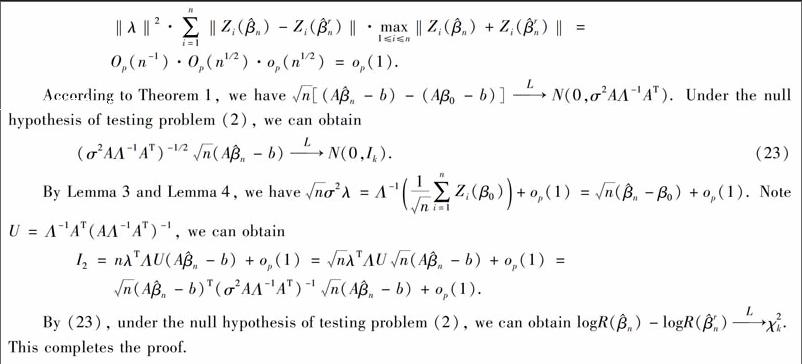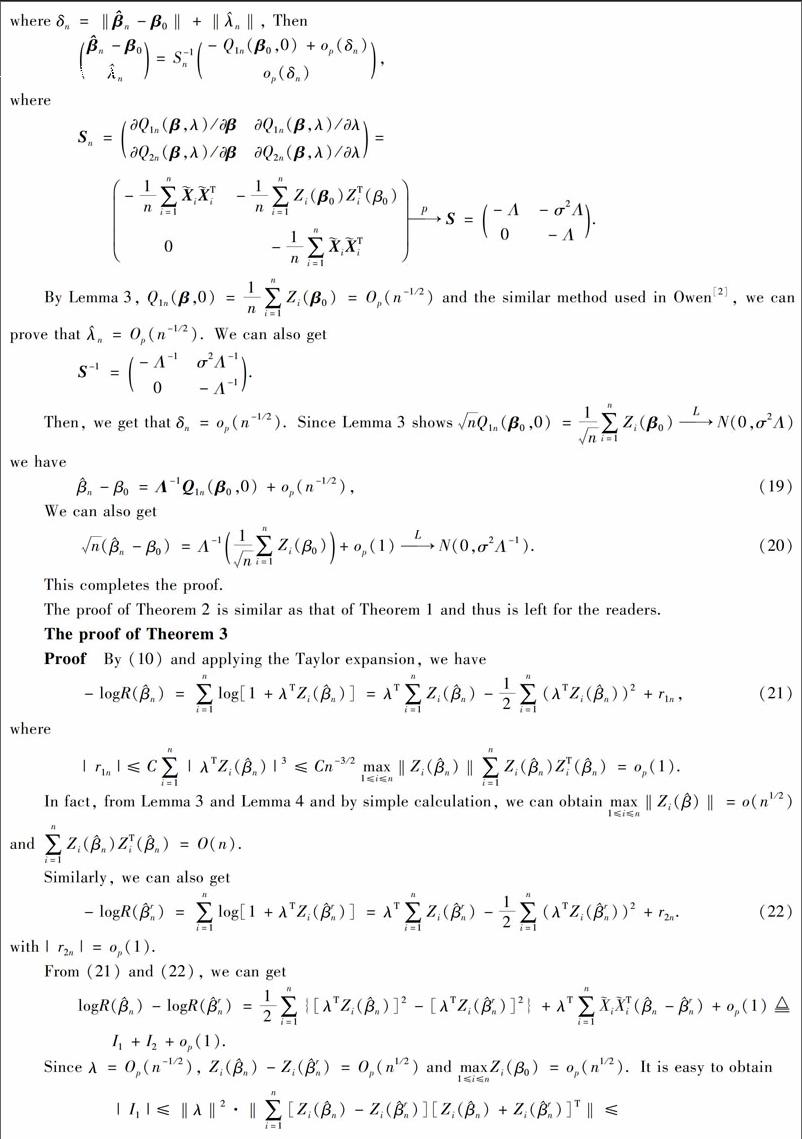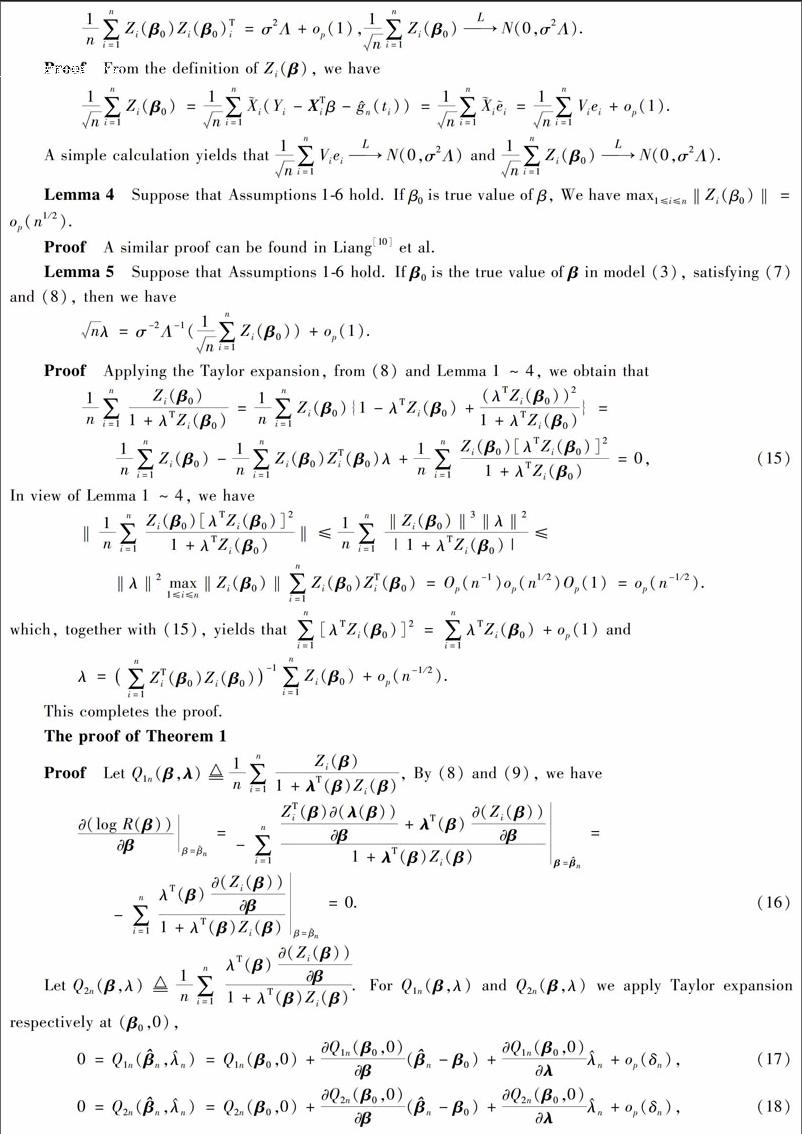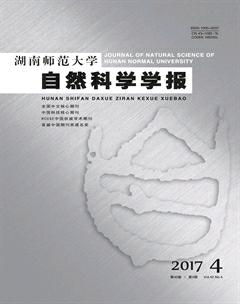具有限制条件的部分线性模型的经验似然推断(英文)
刘常胜+李永献



摘 要 本文將经验似然方法应用到具有限制假设条件的部分线性模型中. 为了检验假设条件, 构造基于零假设和对立假设条件下的极大经验对数似然比估计值的差值统计量. 而且在零假设下证明该统计量的极限分布为标准的χ2分布. 数值模拟表明所提出的检验统计量的优势.
关键词 经验似然; 限制条件; 部分线性模型; 假设检验; χ2分布
It is well known that there are some striking advantages with the empirical likelihood (EL) method proposed by Owen[1-2] in the construction of confidence intervals for unknown parameter, e.g., it turns out that by using the empirical likelihood method, one does not have to explicitly estimate the asymptotic variance of the quantity. The EL method only uses the data to determine the shape and orientation of confidence regions. Note that using empirical likelihood for confidence interval is a well known procedure in nonparametric statistics. The EL method has been applied to partially linear regression model by Shi and Lau[3], Wang and Jing[4-5].
For a long time, however, its main theory was about the parametric regressions. The aforementioned articles mainly discussed the estimation of the parametric component rather than testing. In practice, after solving the problems of identification and fitting of the model (1), one of the further inference issues is to evaluate if certain explanatory variables in the parametric components influence the response significantly. The study of this issue is also one of the important aspects in regression analysis because it is not only useful in variable selection but also in explanatory power.
Motivated by the above, we shall apply EL method to the partially linear model with restricted condition. More generally, we consider the following linear hypothesis:
The rest of this paper is organized as follows. In Section 2, applying the profile empirical likelihood procedure, we construct the empirical likelihood estimator on parameter with linear restriction and without any restriction. In Section 3, we construct the test statistic and study its asymptotic distribution. In Section 4, simulations are conducted to examine the performance of the proposed approaches. The proofs of the main results are given in Section 5.
1 Empirical likelihood estimation on parameter
For the need of constructing the test statistic, we first develop estimating approach for model (1) under the null hypothesis in this section. That is, we estimate the unknown quantities in model (1) with the restricted condition Aβ=b. Then model (1) can be written as
We summarize our findings as follows. When the null hypothesis is true (that is, c=0), the rejection frequencies (estimated sizes) of both our proposed test based Tn and the restricted least-squares approach test based Wn are quite good and close to their nominal levels 0.05 under different error distributions. Under the alternative hypothesis, the rejection rate seems very robust to the variation of the type of error distribution. With the increasing of c, the test power of our proposed test is slightly better than the test based on the residual sum of squares.
References:
[1] OWEN A B. Empirical likelihood ratio confidence intervals for a single functional[J]. Biometrika,1988,75(2):237-249.
[2] OWEN A B. Empirical likelihood ratio confidence regions[J]. Ann Stat, 1990,18(1):90-120.
[3] SHI J, LAU T S. Empirical likelihood for partially linear models[J]. J Multiv Anal, 2000,72(1):132-148.
[4] WANG Q H, JING B Y. Empirical likelihood for partial linear models with fixed designs[J]. Stat Prob Lett, 1999,41(4):425-433.
[5] WANG Q H, JING B Y. Empirical likelihood for partially linear models[J]. Ann Inst Stat Math, 2003,55(3):585-595.
[6] FAN J. Local linear regression smoothers and their minimax efficiencies[J]. Ann Stat, 1993,21(1):196-216.
[7] FAN J, GIJBELS I. Local polynomial modelling and its applications[M]. New Tork: Chapman & Hall Press, 1996.
[8] WEI C, WANG Q. Statistical inference on restricted partially linear additive errors-in-variables models[J]. Test, 2012,21(4):757-774.
[9] LIANG H, HRDLE W, CARROLL R J. Estimation in a semiparametric partially linear errors-in-variables model[J]. Ann Stat, 1999,27(5):1519-1535.
[10] LIANG H, THURSTON S W, RUPPERT D, et al. Additive partial linear models with measurement errors[J].Biometrika, 2008,95(3):667-678.
[11] LIANG H Y, JING B Y. Asymptotic normality in partial linear models based on dependent errors[J].J Stat Plan Infer, 2009,139(4):1357-1371.
[12] 洪圣巖. 一类半参数回归模型的估计理论[J]. 中国科学:A 辑, 1991,34(12):1258-1272.
[13] 孙耀东. 分歧泊松自回归模型的马尔可夫性[J]. 湖南师范大学自然科学学报, 2011,34(4):18-20.
[14] WU C. Some algorithmic aspects of the empirical likelihood method in survey sampling[J]. Stat Sin, 2004,14(4):1057-1068.
[15] XUE L G, ZHU L X. Empirical likelihood for a varying coefficient model with longitudinal data[J]. J Am Stat Assoc, 2007,102(478):642-654.
[16] ZHU L, XUE L. Empirical likelihood confidence regions in a partially linear single-index model[J].J Royal Stat Soc: Ser B, 2006,68(3):549-570.

